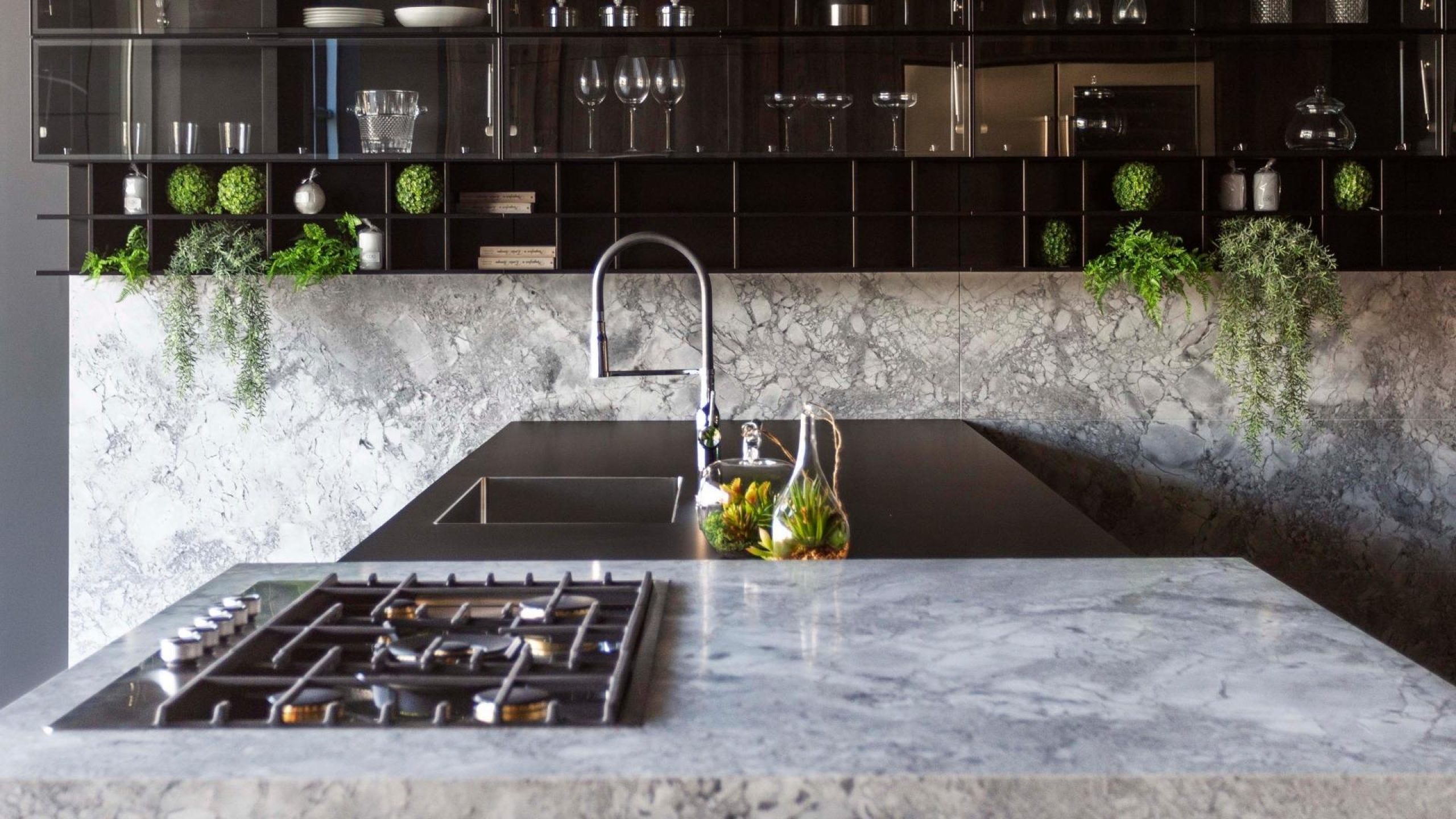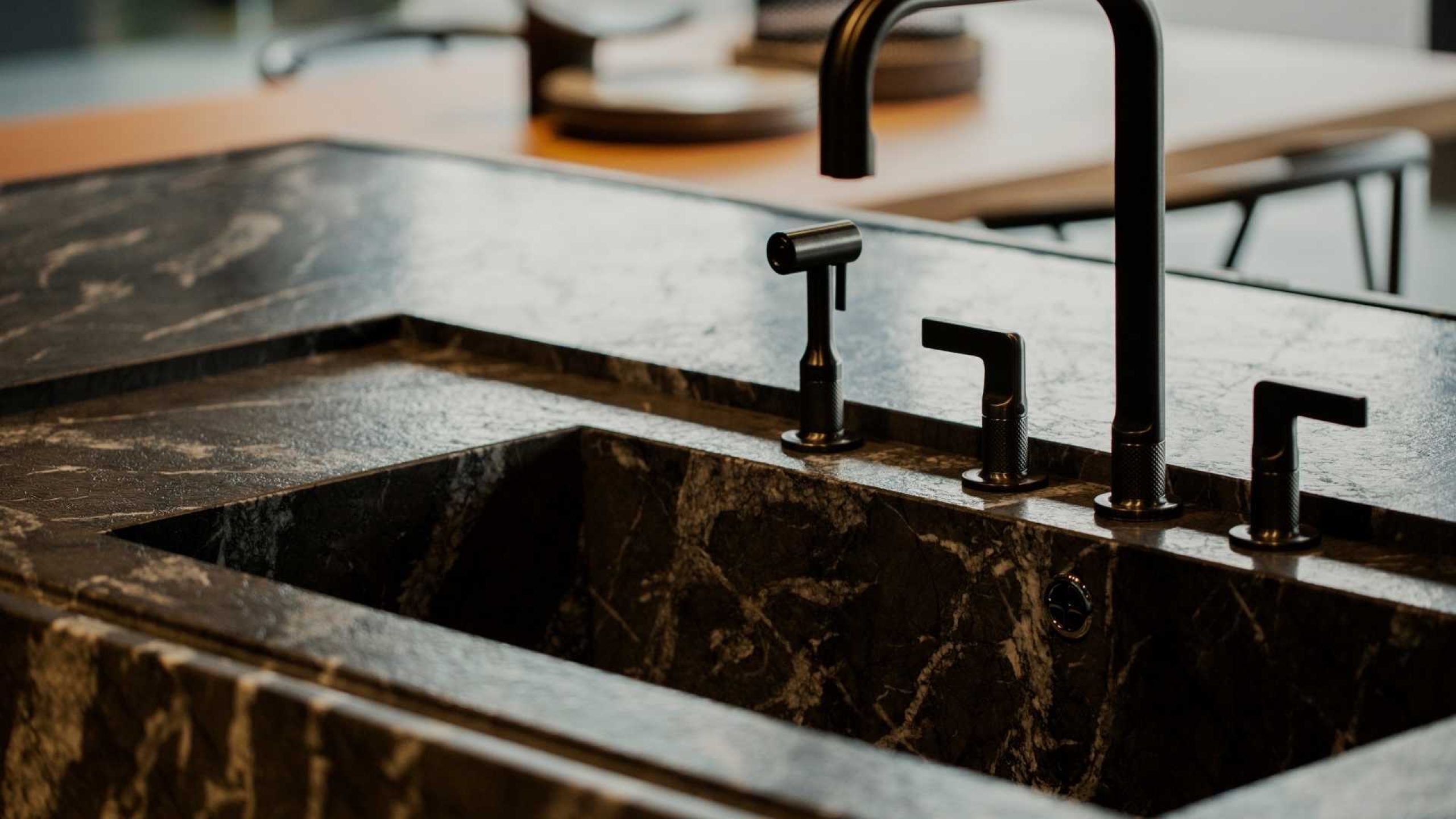October,2023
The marble top: secrets and tricks of the most loved material

Marble minerals and crystals: an elegant surface for your kitchen
If you are looking for a solution that includes an elegant and durable countertop for your kitchen, perhaps you could join the millions of Italians who have grown to love the colored minerals and natural crystals of marble.
In fact, marble is a material that has fascinated mankind for millennia and continues to be the most popular choice for domestic environments. With its history rich in works of art and immortal monuments, marble has acquired a truly timeless charm. But what is the best use of this material in Italian kitchens? And above all, what are the advantages and disadvantages of a marble kitchen? Do you really need a lot of maintenance? Or is it enough to pay attention to a few small details to ensure a long-lasting and beautiful kitchen?
Marble: strengths and weaknesses of a material loved for millennia
Il marmo è una pietra metamorfica che deriva dalla trasformazione del calcare o della dolomite nel sottosuolo. Questa trasformazione, in maniera del tutto simile a quella che trasforma il carbonio in diamante, avviene nel sottosuolo grazie alla combinazione di forte calore e pressione.
Le sfumature e le venature sono del tutto casuali e rendono ogni pezzo di marmo un’opera d’arte naturale unica nel suo genere.
Marble is a metamorphic stone that derives from the transformation of limestone or dolomite underground. This transformation, in a very similar way to that which transforms carbon into diamond, occurs underground thanks to the combination of strong heat and pressure.The shades and veins are completely random and make each piece of marble a one-of-a-kind natural work of art.
The color range available to create a kitchen top is very wide and goes from light and warm tones to dark and intense ones. This allows you to personalize the top perfectly to match the style of the surrounding environment, thus adapting to everyone's needs.
In addition to its much-loved aesthetic appearance, however, marble also boasts notable resistance and durability. Despite being a porous stone, meaning it absorbs a lot, it is able to withstand impacts and abrasions well, minimizing any accidental damage it may suffer. With the right care and maintenance, a marble top can keep its beauty and functionality intact for many years.
So here is a small summary for you of the great advantages of a marble kitchen top:
Unparalleled aesthetics.
The natural appearance and intrinsic elegance of marble give the kitchen a touch of class and refinement that is difficult to replicate with other materials.
Variegation of colors and veins.
In fact, each piece of marble is unique, with designs and veins that add depth and character to the surface of the top.
Stylistic versatility.
This is because marble suits a wide range of furnishing styles, from classic to modern, and can be easily combined with other furnishing elements.
Heat resistance.
Marble is an excellent conductor of heat, making it ideal for working directly with hot food on the surface of the hob without damaging it.
Durability over time.
When treated with care, marble can retain its beauty for generations, making it a long-term investment in your kitchen.
So here is a small summary of the disadvantages of marble for you:
Porosity and stains.
As already mentioned, marble is naturally porous. This means it can stain easily if not sealed properly. Substances such as acids and dyes can penetrate its porosity, leaving permanent stains capable of permanently ruining the aesthetic quality of the marble kitchen top.
Sensitivity to acids.
Acids are contained in some foods, drinks and everyday detergents. These can damage the marble, corroding its surface and leaving indelible marks. There are products that can be applied to the surface to protect the marble, but they must be applied by professionals and in any case, in the long run, they can lose resistance. This is why if you have a marble kitchen top you must always pay close attention to acids, the greatest enemies of marble.
Maintenance required.
This is one of the most fought over defects. Everyone tries to somehow evade it but it's not possible: a marble top requires specific care and ordinary and extraordinary maintenance to preserve its beauty and protect it from stains.
Periodic sealing and cleaning with gentle detergents are essential to say the least.
High cost.
This is also a flaw of marble, because it is considered a luxury material, so its price is generally higher than other kitchen countertop options.
But then what are the secrets of perfect maintenance for the marble kitchen top?
The secrets of perfect maintenance for the marble kitchen top
Here are some useful maintenance tips that you can apply from day one to ensure the maximum lifespan of your marble kitchen worktop:
Apply a protective seal to the marble countertop to reduce porosity and protect it from stains. The frequency of sealing will depend on the use of the countertop and the type of sealant used.
Sealing the marble regularly is essential to therefore reduce porosity and protect it from stains. Sealing should be done with quality products, following the manufacturer's instructions.
Use specific detergents for marble or neutral soap and water-based solutions for daily cleaning. Avoid using acidic cleaners or abrasive substances that could damage the surface. In fact, cleaning marble should be carried out with extreme care using only delicate and non-abrasive detergents. Avoid using rough sponges or rags that could scratch the marble surface. Acidic and abrasive cleaners can damage the patina of the marble and leave permanent stains. Also, always remember to always dry the marble surface after cleaning it to avoid the formation of water stains.
Whenever possible, avoid placing acidic foods or drinks directly on the marble surface. Use cutting boards and coasters to avoid direct contact with harmful substances and thus prevent more stubborn stains.
Avoid dropping heavy objects or hitting the marble surface forcefully to prevent chipping and cracking. Of course, accidental impacts cannot be prevented and marble still remains a very resistant material, but with a little prevention the risks can be greatly reduced. Furthermore, marble is beautiful, but it is not suitable for all types of businesses. So avoid using the marble top as a work surface for other craft projects, such as clay working or painting. The materials used in these activities could irreparably damage the marble. Use the kitchen counter only as a kitchen counter.
Do not place hot objects directly on the marble surface. This is because even though marble has good heat resistance, it is always better to use coasters or cutlery on an insulating base when placing hot objects on the countertop surface. High temperatures can cause temperature changes and, over time, could damage the structure of the marble or the protective layer that covers it.
Furthermore, a gem that not everyone knows is that marble cutting boards should not be used on a marble kitchen top! While it may look elegant, using a marble cutting board directly on the countertop surface could damage it. Marble is softer than other materials and may be scratched or damaged by blows from the cutting board.
Don't ignore any damage. This is because if you notice chips, cracks or other imperfections on the surface of the marble, an experienced marble restoration professional could correct the damage and restore the original appearance of the countertop before the damage extends or becomes irreparable.
In short, a kitchen with a marble top certainly requires particular care and attention to preserve its beauty and integrity over time. Caring for your marble countertop carefully and following the manufacturer's and professionals' directions can ensure that this fine surface continues to grace your kitchen for many years into the future.

Kitchen with marble top? Buying tips!
Before finally choosing a kitchen with a marble top, there are some aspects you should carefully consider to ensure you make the right choice.
So here are some tips for purchasing a kitchen with a marble top:
Always remember to consider the design and style of your kitchen. Consider carefully whether the marble integrates harmoniously into the surrounding environment, because it may not be so obvious.
Reflect on your cooking habits and level of use of the hob. If you have a busy kitchen, have small children, or pets with nails, you may want to consider a material that is more resistant to stains, scratches, and impacts.
Also evaluate your overall kitchen budget and compare it to marble costs. Our personal advice is to also consider the cost of maintenance and care of the marble over time so as not to have unpleasant surprises.
Make sure you purchase marble from reliable suppliers renowned for material quality and customer service.
Finally, explore the different variations of marble available, with different veins and shades of color, to find the one that best suits your tastes and the design of your kitchen
Why do we love marble so much? For its history
The marble quarries were considered real luxury mines from which blocks of precious stone were extracted to then be sculpted and used in buildings of great historical and cultural importance.
One of the most famous examples of this is the Parthenon in Athens, built in the 5th century BC.
The Greek temple was entirely covered in Pentelic marble, a type of white marble famous for its purity and brightness.
The use of marble has always given buildings an unparalleled grandeur and beauty, and many of these structures have survived to this day, testifying to the durability and resistance of this material.
In fact, even in the Roman Empire, marble was widely used for the construction of temples, theaters, baths and triumphal arches.
The tradition of using marble as a prestigious material has continued over the centuries and reached its peak in terms of use and value during the Italian Renaissance. Artists and architects such as Michelangelo or Leonardo da Vinci have sculpted and used marble to create some of the most famous works of art in history.
Marble statues and monuments have become symbols of beauty and artistic perfection, and marble has become an indispensable material in the construction of noble homes and villas.
Even today, marble is considered a luxury material and continues to be widely used in the high-end construction and architecture industry. Marble quarries are found in many parts of the world, and the variety of colors and types of marble available allow you to create unique and customized architectural designs.
In conclusion, the history of marble as a mineral used for construction is long and fascinating and is perhaps one of the main reasons why it is loved so much by Italians. Finding it in the most elegant kitchens is almost a given now because anyone trying to recall elements of this kind cannot help but choose this material. The need for good maintenance and a certain amount of daily attention are often a small acceptable sacrifice in the face of such elegance and beauty.
And this finally makes marble the perfect material for Italian cuisine.
